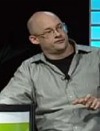Clay Shirky’s talk about the cognitive surplus
Mark Ury, chief experience architect for Blast Radius, was there and wrote about it on his blog “The Restless Mind”:
“His thesis is that in order to grapple with a particularly stressful stretch of time, society engages in some mind-numbing activity that, by consequence, creates a cognitive surplus. Eventually, this surplus overflows and new forms of value are created. He cites post-industrial revolution Londoners blanking out with gin, only to then build many of the modern institutions we cherish today, and post-WWII Americans sitting slack-jawed watching I Love Lucy and Gilligan’s Island, but now using the Internet to produce Wikipedia and, to a lesser order, lolcats.” […]
“What struck me as intriguing in all this wasn’t our cognitive surplus, though. It’s our surplus of interaction.” […]
“Interaction surplus, though, is new. From RSS to email, flickr to FunWalls, posts to pingbacks—we’ve never before had to deal with an abundance of two-way interaction. And unlike the subtle effect of compound interest, hooking more people up to the grid creates a personalized form of Metcalfe’s law, a signal to noise ratio that is overwhelming and, over time, numbing. Watching “connected consumers†tweet, IM, tag, upload, download and go viral is not much different than a Saturday night rave: a blur of consciousness, ephemera, and not a little dizziness.”




